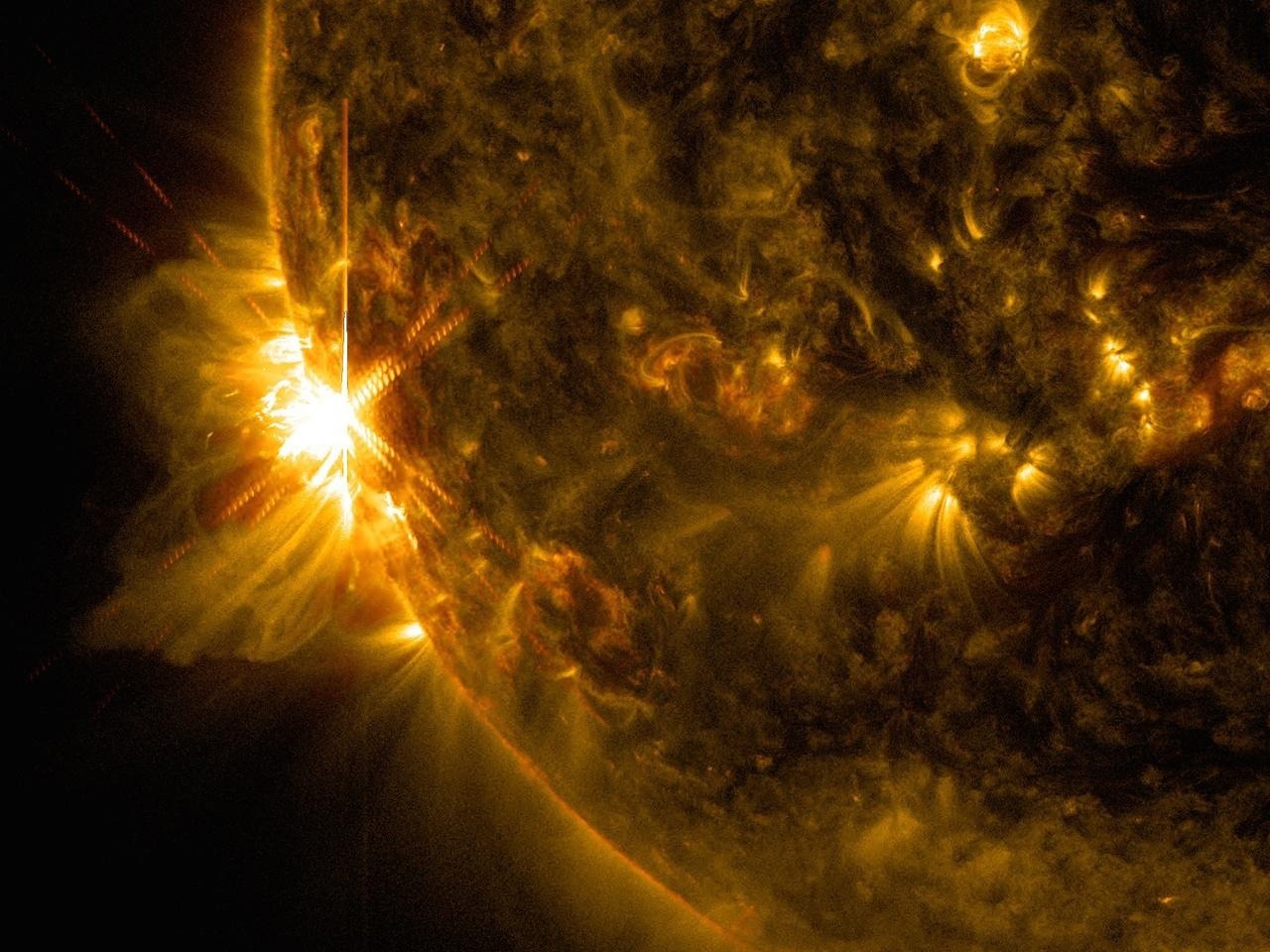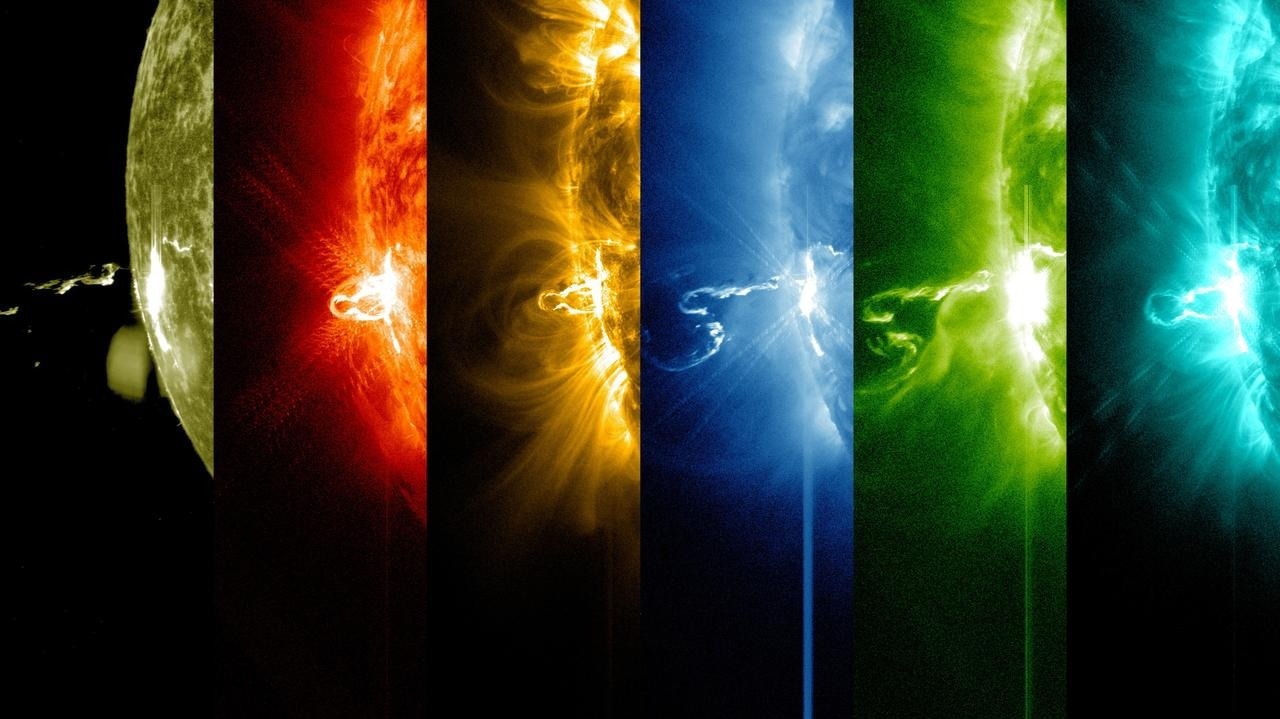High-energy particles and their interactions play a vital role in astrophysics. In the 20th Century, Victor Hess detected the high-energy cosmic rays which ionized the Earth’s atmosphere. This led to a deep interest in astrophysical plasma studies, cosmic outflows, and high-energy particle studies.

Image Credit: A solar flare bursts off the left limb of the sun in this image captured by NASA's Solar Dynamics Observatory on June 10, 2014, at 7:41 a.m. EDT. This is classified as an X2.2 flare, shown in a blend of two wavelengths of light: 171 and 131 angstroms, colorized in gold and red, respectively. Image Credit: NASA/SDO/Goddard/Wiessinger
Solar Flares: An Exciting Astrophysical Phenomena
Solar flares are eruptions from the surface of the sun, characterized by the emission of intense bursts of electromagnetic radiation. The flares appear as an intense but vivid region with increased brightness on specific regions of the sun, with the intensity duration ranging from several minutes to several hours.
The amount of energy emitted during a solar emission is massive, nearly equivalent to hundreds of 100-megaton hydrogen bombs. The solar flare releases emissions with varying frequencies along the entire electromagnetic spectrum.
Entangled Magnetic Fields: Reason behind the Solar Flares
The movement of electrically charged gases leads to the development of magnetic fields within the sun, resulting in electrical currents that operate as a magnetic dynamo. The turbulent gases cause twisting, tangling, and reconfiguration of the magnetic fields. The varying behavior of magnetic fields, also known as solar activity, is the core reason for solar flares.
Solar flares are often detected by instruments sensitive to high-energy wavelengths. The image below portrays a solar flare imaged across six distinct wavelengths of ultraviolet light, a spectrum that is imperceptible to the human eye. This ultraviolet imagery offers valuable insights into the dynamics of solar flares and their associated phenomena.

These SDO images from 7:25 p.m. EST on Feb. 24, 2014, show the first moments of an X-class flare in different wavelengths of light -- seen as the bright spot that appears on the left limb of the sun. Hot solar material can be seen hovering above the active region in the sun's atmosphere, the corona. Image Credit: NASA/SDO
Classification of Solar Flares
The classification of solar flares by NASA is done as per the intensity of X-ray emissions, which is useful in differentiating the flares based on their impacts. A-class flares are the weakest solar flares types, which are the least impactful. They do not influence the Earth and aren’t a major concern.
B-class flares have more intensity than A-class and may cause minor disruptions in radio signal communication on Earth. Specifically, high-frequency radio signals over the polar regions are affected by B-class solar flares. C-class flares are very strong solar flares and exceed the B-class solar flares in intensity by about 10 times. These are superseded by the M-class flares and, finally the strongest, X-class flares.
How do Solar Flares Affect Earth’s Magnetosphere?
The magnetosphere is the uppermost layer of the Earth’s space atmosphere. The dynamic behavior of its completely ionized and non-colliding plasma is primarily regulated by Earth’s magnetic field along with space-induced interactions.
Researchers have conducted a study in a recent article published in Nature Physics to study the effects of solar flares on the Earth’s magnetosphere. The researchers developed a novel comprehensive geo-space model and utilized it in conjunction with the actual data from the (X9.3) solar flare event of September 6, 2017.
This detailed setup was done to unveil the impact of solar flares on the magnetosphere dynamics and the electrodynamic interaction between the magnetosphere and the ionosphere, which is the ionized segment of Earth's upper atmosphere.
The research team witnessed a swift and substantial rise in photoionization caused by the solar flare in the polar ionospheric E-region, specifically within the altitude range of 90 to 150 kilometers. This also led to a decrease in the efficiency of mechanical energy conversion during the interaction between the solar wind and magnetosphere on the daytime side.
The major outcome of this decrease was the reduction in Joule heating in the upper Earth’s atmosphere. This study reveals that the effects of solar flares permeate the entire geo-space via electrodynamic interconnection and are not confined, as previously believed, solely to the atmospheric layer where radiation energy is absorbed.
What are Astrophysical Jets?
Astrophysical jets are simply outward-focused streams of plasma particles and fields that are observed while investigating various galactic and extragalactic bodies. These bodies usually include Active Galactic Nuclei (AGNs), black holes, recently formed celestial bodies known as young stellar objects (YSOs), and high-energy phenomena like gamma-ray bursts (GRBs). The first ever astrophysical jet was observed in 1918.
The shapes of astrophysical jets vary significantly based on the surrounding magnetic field. In a recent study published in Nature Communications, scientists have discovered that the misalignments in the magnetic field are critical factors governing the formation of these jets.
The potential conditions for astrophysical jets were replicated by the research team using high-intensity laser equipment generating material outflows within a strong applied magnetic field.
When minor misalignments were introduced, a magnetic nozzle formed during the experiment and guided the outflow into a focused jet. However, with increasing misalignments, the asymmetry in the nozzle increased, interfering with the formation of the jet. The results indicated that the misalignment between outflows and the magnetic field could indeed be a pivotal mechanism governing the concentration of jets in a range of objects, spanning from the Sun's outflows to extragalactic jet phenomena.
The dynamic behavior of both cosmic jets and solar flares is dependent on magnetic field variation due to irregularities in the behavior of plasma particles. The complex and dynamic interactions of plasma particles must be studied in detail. A comprehensive understanding of plasma interactions requires an in-depth study of plasma physics. Researchers utilize a combination of theoretical paradigms, computer-based simulations, and practical observations to enhance their comprehension of the intricate phenomena unfolding within astrophysical plasmas.
Celestial Mechanics: Exploring the Orbits of Planets and Satellites
References and Further Reading
Dobrijevic, D., (2022). Solar flares: What are they and how do they affect Earth?. [Online]
Available at: https://www.space.com/solar-flares-effects-classification-formation
Space Weather Prediction Center, (2023). Solar Flares (Radio Blackouts). [Online]
Available at: https://www.swpc.noaa.gov/phenomena/solar-flares-radio-blackouts
Revet, G. et al. (2021). Laboratory disruption of scaled astrophysical outflows by a misaligned magnetic field. Nat Commun 12, 762 (2021). Available at: https://doi.org/10.1038/s41467-021-20917-x
UCAR Center for Science Education, (2023). Solar Flares. [Online]
Available at: https://scied.ucar.edu/learning-zone/sun-space-weather/solar-flare
Liu, J. et al. (2021). Solar flare effects in the Earth’s magnetosphere. Nat. Phys. 17, 807–812. Available at: https://doi.org/10.1038/s41567-021-01203-5
Disclaimer: The views expressed here are those of the author expressed in their private capacity and do not necessarily represent the views of AZoM.com Limited T/A AZoNetwork the owner and operator of this website. This disclaimer forms part of the Terms and conditions of use of this website.